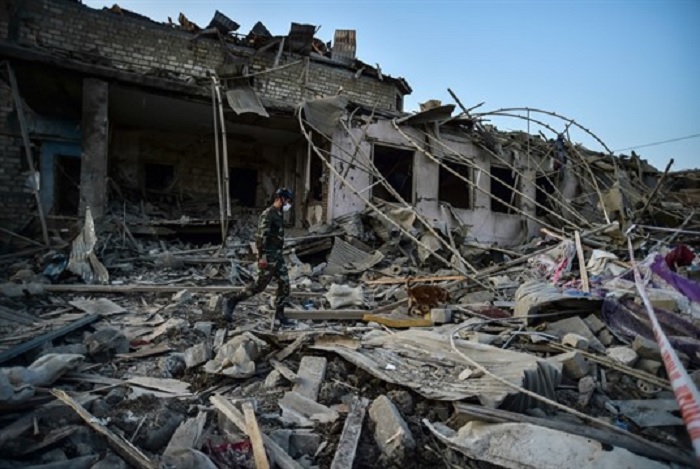
Until late last month, the conflict between Armenia and Azerbaijan over the disputed territory of Nagorno-Karabakh had been mostly frozen, with occasional skirmishes, for over a quarter of a century. One notable exception was the April 2016 “four-day war,” a brief but intense period of fighting that left over 200 people dead and was followed by claims of victory from both sides. The recent fighting that erupted on Sept. 27 has been much more intense; over 600 soldiers have been killed on the Armenian side alone, along with scores of civilians and an undisclosed number of Azerbaijani personnel.
While the fighting is officially between Azerbaijan and Nagorno-Karabakh’s ethnic Armenian population, in reality, it includes neighboring Armenia, which effectively administers the self-declared and unrecognized Nagorno-Karabakh Republic. Another direct belligerent, albeit an unofficial one, is Turkey, which in recent months has conducted joint military exercises with Azerbaijan and has been providing it with military and technical assistance for many years.
There are several reasons why the conflict has flared up again. First is the lack of progress by the so-called Minsk Group, which was set up in 1992 under the auspices of the Organization for Security and Cooperation in Europe to mediate a permanent peace agreement between Armenia and Azerbaijan. Co-chaired by France, the United States and Russia, the Minsk Group is increasingly seen in the region as ineffectual. Frustration with the lack of progress in resolving the conflict has been more visible among Azerbaijani leaders, who have been arguing for decades that their country’s territorial integrity is being violated by Armenia. Authorities in Nagorno-Karabakh counter that the enclave’s majority ethnic-Armenian population is merely exercising its right to self-determination.
The second factor is the relative disengagement of the United States from the South Caucasus specifically, and from Russia’s “near abroad” in general. U.S. absenteeism under the Trump administration has left the door open for Russia, as well as Turkey, to reassert their influence in the region.
For foreign policy observers, the relationship between Turkey and Russia is an enigma. The two countries have engaged in a delicate diplomatic tango in recent years, at times appearing to work in tandem, increasing their economic and even military cooperation. Their leaders, Recep Tayyip Erdogan and Vladimir Putin, generally share a disdain for the West. Yet they also find themselves on opposite sides of some conflicts, such as in Syria and Libya, and they weathered a serious diplomatic crisis in 2016, when Turkish forces shot down a Russian fighter jet near the Turkey-Syria border.
Moscow has a longstanding desire to expand its influence in the South Caucasus by putting boots on the ground in Nagorno-Karabakh.Now, they are again at odds in the South Caucasus. Turkey’s open and forceful backing of Azerbaijan against Armenia is widely seen as a challenge to Moscow and a sign of Russia’s weakness in a region where it historically exercised considerable influence. Some analysts have suggested that Russia may have even been caught off guard by the new offensive, and by Turkey’s unprecedented military support for Azerbaijan.
But the Kremlin was almost certainly aware of the imminent military escalation. Even the U.S., with its passive presence in the region, was informed enough to issue a warning through its embassy in Azerbaijan on Sept. 25—two days before fighting erupted in earnest—alerting U.S. citizens of “heightened tensions and recent violence along portions of the Armenia-Azerbaijan border.” Moscow, with its deep interests in the region, must have known well in advance of not only the possibility of war, but likely also some details of Turkey’s involvement.
The question that looms large, then, is why Russia, which has a formal alliance with Armenia through the six-member Collective Security Treaty Organization, and which Yerevan views as an important military partner, has been so slow in trying to stop the fighting. It took Moscow four days to issue an official statement asking both sides to deescalate, and almost two weeks to broker a humanitarian cease-fire between the Armenian and Azerbaijani foreign ministers—which broke down in a matter of hours.
Russia’s foot-dragging is partly a sign of its cool attitude toward Armenia’s reformist prime minister, Nikol Pashinyan, who came to power over two years ago after a wave of peaceful protests that have sometimes been called the country’s “Velvet Revolution.” While Moscow formally accepted the transition of power in Yerevan, it regarded Pashinyan with some suspicion, viewing the transition process as somewhat akin to previous “color revolutions” in former Soviet countries, especially the 2003 Rose Revolution in Georgia and the Orange Revolution the following year in Ukraine. Those events brought to power pro-Western leaders who attempted to pull away from Russia’s orbit.
The second, and arguably more important reason why Russia has not rushed to Armenia’s side, might paradoxically lie in Moscow’s longstanding desire to expand its influence in the South Caucasus by putting boots on the ground in Nagorno-Karabakh, outside of the Minsk Group framework. To this end, Russia has renewed its push for the parties to adopt the so-called Lavrov Plan, named after Russian Foreign Minister Sergey Lavrov. Essentially, it stipulates that Armenia give up most of the territory that it controls in Nagorno-Karabakh, with Russia providing peacekeepers to oversee a phased resolution to the conflict—a proposal that Armenia has repeatedly rejected.
Over the weekend, a second cease-fire, this time mediated by France in coordination with the U.S. and Russia, broke down again. With no end in sight to the fighting and heavy casualties mounting on both sides, Yerevan might be more willing to accept the Lavrov Plan, or some variation of it, allowing Russia to reassert itself as the main security guarantor in the region. Just how easily Armenia will come around to the idea, though, remains to be seen.
 Eurasia Press & News
Eurasia Press & News

